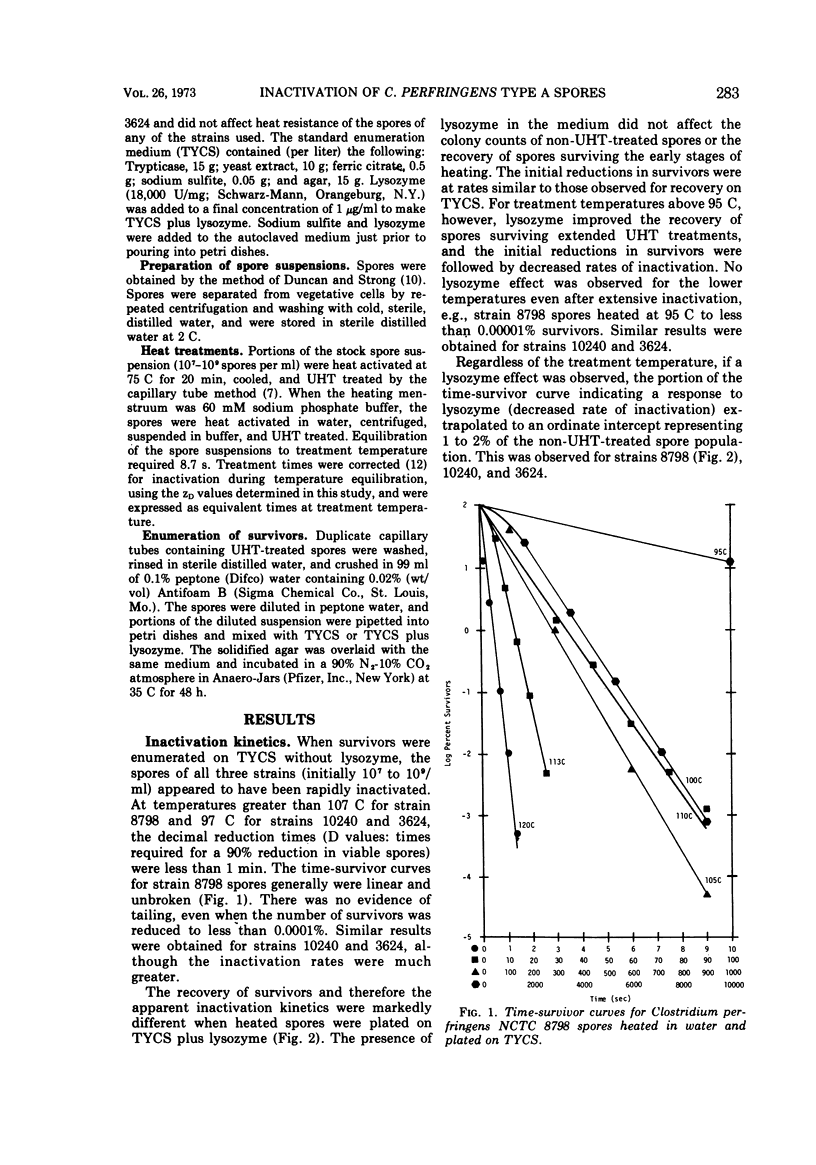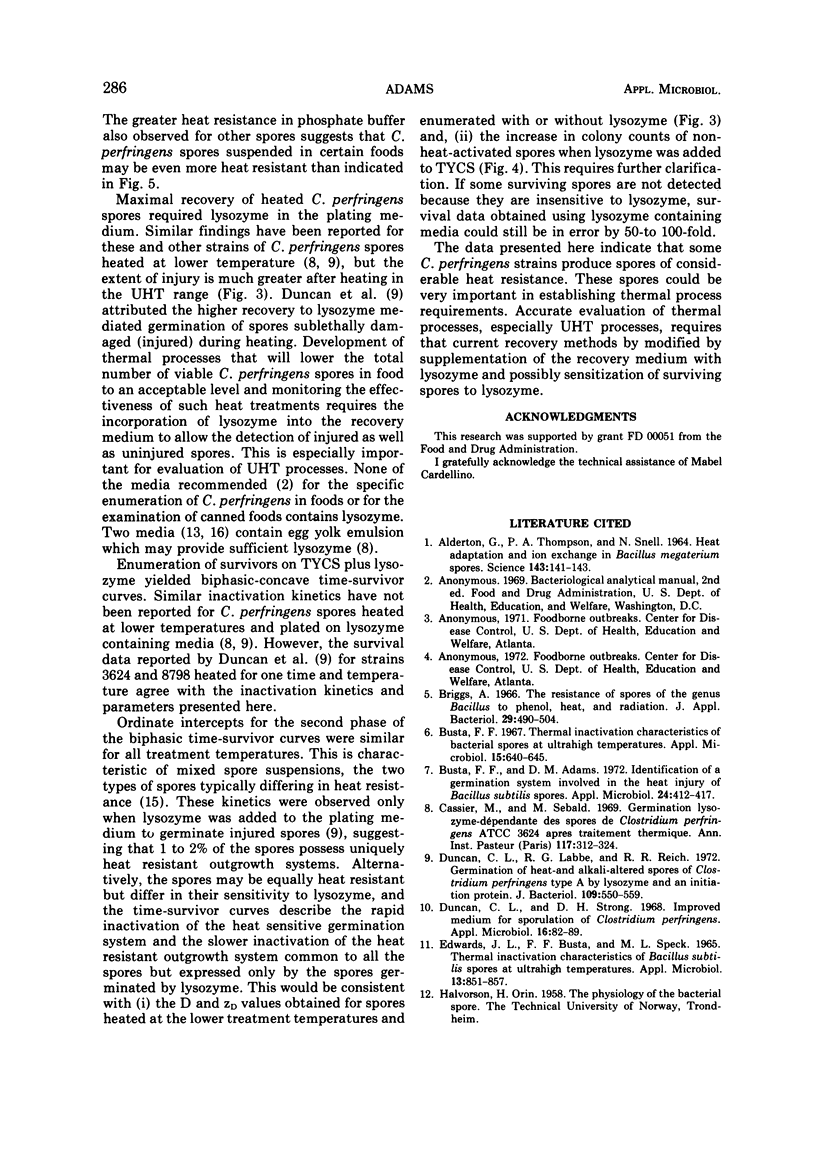Abstract
The inactivation of Clostridium perfringens type A spores (three strains of different heat resistances) at ultrahigh temperatures was studied. Aqueous spore suspensions were heated at 85 to 135 C by the capillary tube method. When survivors were enumerated on the standard plating medium, the spores appeared to have been rapidly inactivated at temperatures above 100 C. The addition of lysozyme to the plating medium did not affect the recovery of spores surviving the early stages of heating, but lysozyme was required for maximal recovery of spores surviving extended heat treatments. The percentage of survivors requiring lysozyme for colony formation increased greatly with longer exposure times or increasing treatment temperature. Time-survivor curves indicated that each spore suspension was heterogeneous with respect to the heat resistance of spore outgrowth system or in the sensitivity of the spores to lysozyme. Recovery of survivors on the lysozyme containing medium revealed greater heat resistance for one strain than has been reported for spores of many mesophilic aerobes and anaerobes. The spores of all three strains were more resistant to heat inactivation when suspended in phosphate buffer, but a greater percentage of the survivors required lysozyme for colony formation.
Full text
PDF





Selected References
These references are in PubMed. This may not be the complete list of references from this article.
- ALDERTON G., THOMPSON P. A., SNELL N. HEAT ADAPTATION AND ION EXCHANGE IN BACILLUS MEGATERIUM SPORES. Science. 1964 Jan 10;143(3602):141–143. doi: 10.1126/science.143.3602.141. [DOI] [PubMed] [Google Scholar]
- Briggs A. The resistances of spores of the genus Bacillus to phenol, heat and radiation. J Appl Bacteriol. 1966 Dec;29(3):490–504. doi: 10.1111/j.1365-2672.1966.tb03500.x. [DOI] [PubMed] [Google Scholar]
- Busta F. F., Adams D. M. Identification of a germination system involved in the heat injury of Bacillus subtilis spores. Appl Microbiol. 1972 Sep;24(3):412–417. doi: 10.1128/am.24.3.412-417.1972. [DOI] [PMC free article] [PubMed] [Google Scholar]
- Busta F. F. Thermal inactivation characteristics of bacterial spores at ultrahigh temperatures. Appl Microbiol. 1967 May;15(3):640–645. doi: 10.1128/am.15.3.640-645.1967. [DOI] [PMC free article] [PubMed] [Google Scholar]
- Cassier M., Sebald M. Germination lysozyme-dépendante des spores de Clostridium perfringens ATCC 3624 après traitement thermique. Ann Inst Pasteur (Paris) 1969 Sep;117(3):312–324. [PubMed] [Google Scholar]
- Duncan C. L., Labbe R. G., Reich R. R. Germination of heat- and alkali-altered spores of Clostridium perfringens type A by lysozyme and an initiation protein. J Bacteriol. 1972 Feb;109(2):550–559. doi: 10.1128/jb.109.2.550-559.1972. [DOI] [PMC free article] [PubMed] [Google Scholar]
- Duncan C. L., Strong D. H. Improved medium for sporulation of Clostridium perfringens. Appl Microbiol. 1968 Jan;16(1):82–89. doi: 10.1128/am.16.1.82-89.1968. [DOI] [PMC free article] [PubMed] [Google Scholar]
- Edwards J. L., Jr, Busta F. F., Speck M. L. Thermal inactivation characteristics of Bacillus subtilis spores at ultrahigh temperatures. Appl Microbiol. 1965 Nov;13(6):851–857. doi: 10.1128/am.13.6.851-857.1965. [DOI] [PMC free article] [PubMed] [Google Scholar]
- Harmon S. M., Kautter D. A., Peeler J. T. Improved medium for enumeration of Clostridium perfringens. Appl Microbiol. 1971 Oct;22(4):688–692. doi: 10.1128/am.22.4.688-692.1971. [DOI] [PMC free article] [PubMed] [Google Scholar]
- Roberts T. A. Heat and radiation resistance and activation of spores of Clostridium welchii. J Appl Bacteriol. 1968 Mar;31(1):133–144. doi: 10.1111/j.1365-2672.1968.tb00350.x. [DOI] [PubMed] [Google Scholar]
- Shahidi S. A., Ferguson A. R. New quantitative, qualitative, and confirmatory media for rapid analysis of food for Clostridium perfringens. Appl Microbiol. 1971 Mar;21(3):500–506. doi: 10.1128/am.21.3.500-506.1971. [DOI] [PMC free article] [PubMed] [Google Scholar]


